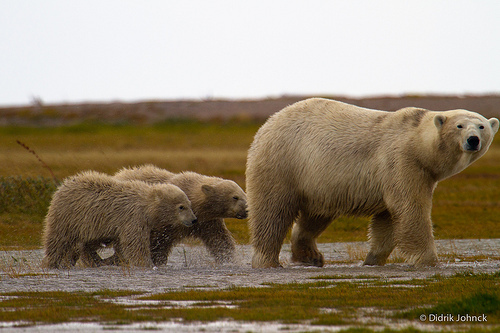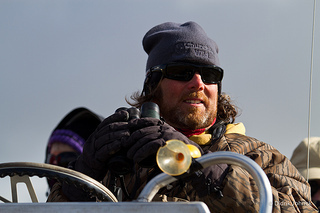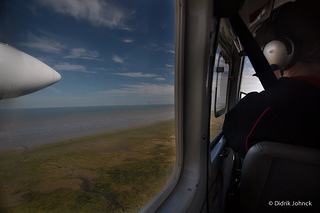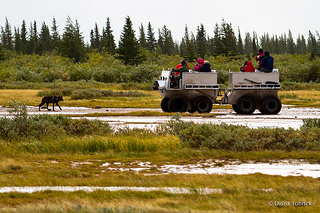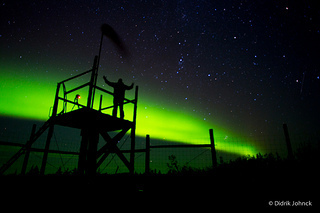Lisa Niver's Blog: We Said Go Travel, page 446
December 4, 2013
George´s Music Review: “Who’s Psychotic Next?”
“Who Am I” is legendary The Who composer and guitarist Pete Townshend’s autobiographic memoir that he began in May, 1996. The original manuscript was 1,000 pages long but editor Harper Collins shaved it in half to 500 pages. The chronicle delves into Townshend’s upbringing in England, explains the development of The Who, and later probes into Townshend’s struggles as a rock star as he battles with drugs, alcohol and fidelity.
Pete Townshend’s memoir opens with his childhood in London that immediately followed World War II in May 1945. He lived with his grandmother who allegedly sexually and mentally tormented Townshend based on his limited childhood recollections. His childhood “issues” reappear during Townshend’s memoir with alarming frequency.
Townshend’s stage antics developed primarily by accident and imitation. He claims, “I started smashing his guitars at the end of performances after accidentally pushing one through a club ceiling in 1964 and damaged it.” When the fans went wild, he adopted it into his performance which later led Keith Moon to topple over his drum kit and trash hotels. Townshend admits that his trademark “windmill” style of strumming guitar chords was espoused from Keith Richards who warmed-up by swinging his arm prior to going on stage. He explains that music he heard in his head as a child affected his music, eventually developing into rock operas such as Tommy and Quadrophenia.
Townshend’s sexuality was often probed throughout his book. He describes himself as bisexual because of a sexual encounter with a male journalist and his sexual interest in Mick Jagger. The other The Who members were so disgusted with Townshend’s lack of sexual prowess that they paid a prostitute to infect him with gonorrhea. Distancing himself from life as a rock star, he studied under Indian guru Meher Baba. While under Baba’s tutelage, Townshend avoided drugs and adultery but he periodically descended into the world of drugs, alcohol and female lovers.
Life after The Who led to Townshend’s employment as an editor at Faber and Faber where he commissioned literature and began philanthropic charity work including the establishment of a shelter for battered wives. His charitable work led to problems and Townshend was arrested for supposedly downloading child-pornography. Townshend explained that he was fighting child-pornography by setting up a research program support system for survivors of childhood abuse. He was given a formal police caution because Townshend “was in no frame of mind to live through another eternity – this time in court.” He later wished he had gone to trial to prove his innocence.
Townshend’s insightful autobiography is worthwhile in how it accounts his creative process in creating music. This memoir is comprehensive, intimate, and candid. The memoir uniquely explores deeply into Townshend’s mental state and psyche. He exposes his defects as an angry guitar hero, delves into his mind as an introspective composer, and contrasts the segment of his being that is a spiritual seeker versus the hedonistic drug user that he returned to often. At times Townshend appears tortured, unable to cope with life as he searches for something beyond his reach.
Even though the memoir was chopped in half, book editing was uneven at times, with either too much detail or choppy incomplete narrative. His intellectual tone lacked exuberance and created a dull narrative while he crams too much down the reader’s throat. This chronicle is recommended exclusively to dedicated hard-core Pete Townshend fans that will appreciate every minute detail that he does an impressive job of recalling. However, even die-hard The Who fanatics would be better off reading a The Who biography than sitting through an opera when you really wanted to listen to classical music.
“Who’s Psychotic Next?” first appeared in the Huffington Post.
About this review: George Rajna, MBA, MS Communications Disorders, is a bilingual speech therapist who has traveled to 100 countries across six continents. He composes music on the guitar and ukulele, and spent two years working in rural education for Peace Corps Paraguay. He is the co-author of Traveling in Sin and has been on the road with his wife since July 2012. Follow their journey at We Said Go Travel.
The post George´s Music Review: “Who’s Psychotic Next?” appeared first on We Said Go Travel.
Himalayas: Stone God
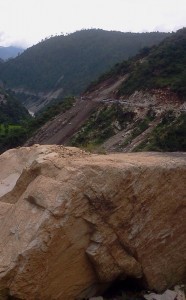 Like an injured animal crawling on its belly, our vehicle was cautiously inching along. Outside, contours of the mountains were wet with tearing rain while inside, our cheeks were the same with tears. None showed any signs of abating. Clasped palms and quivering lips in focused devotion were desperately trying to evoke the attention of Lord Shiva, from whose Himalayan abode we were returning after a brief rendezvous.
Like an injured animal crawling on its belly, our vehicle was cautiously inching along. Outside, contours of the mountains were wet with tearing rain while inside, our cheeks were the same with tears. None showed any signs of abating. Clasped palms and quivering lips in focused devotion were desperately trying to evoke the attention of Lord Shiva, from whose Himalayan abode we were returning after a brief rendezvous.
The scene outside was extremely scary. An inhospitable weather coupled with a cocktail of mist and rain had considerably devoured the visibility. It would have been better if our hearing too had got negated, but no! A swelling river thundering away at sneezing distance was menacingly inviting us was into her freezing embrace.
The river did not seem the same entity which had danced all the way along us a week ago as we ascended the mighty mountains to seek salvation at the feet of the divine. That mountain maiden was calm, chirpy and cheerful. But the sudden unseasonal train of rains had transformed her into a demon, eager to destruct and devour. Reined in the name of hydropower and raped in the name of development, the river had finally managed to break free of all barriers and was reveling in her new-found freedom.
Suddenly at a serpentine turn, our snails’ pace was abruptly halted by a roadblock – a gigantic boulder had fallen off the mountain and lay right on the middle of the road. There was no way we could move ahead- the space towards the mountainside was insufficient for our vehicle to squeeze through, while attempting that stretch which dropped right down into the river would simply be suicidal.
“We will have to wait here till tomorrow morning!” our driver announced with an air of finality and parked the vehicle at the side of the mountain. As I looked up, I could see similar-sized boulders positioned above, waiting to roll down on us.
No one said anything. But the look on our faces said it all–everyone, including me was confirmed that we had reached the end of our mortal existence. Stranded in the middle of nowhere, all through the dying evening and deadly night, we sat imprisoned in the vehicle paralyzed with panic, while all around us the wild wind howled and danced in harmony with the fast descending downpour.
It was around midnight when the rains halted, the first time in the last three days. The skies cleared up and stars emerged, shining so brightly that their luminance surpassed that of the moon.
At dawn the sight which met our eyes served a confirmation that yesterday our prayers to the Almighty had not gone unheeded. The stretch of the road immediately after the boulder had caved in and disappeared into the river roaring below. Yesterday, in the dwindling twilight, had we not been stopped by the stone, which we had silently cursed throughout the night, by now all of us would have been resting in our watery graves.
Slowly the earth woke up. The sky was a clear cloudless blue and there was no trace of yesterday’s calamity. The sun shone brightly and the air was full of birdsong. The rising emotions of the river too had got subdued and she was her normal self once again.
We sat near our savior. Till then, it was just another non-living mass, an obstacle in our path of escape from the tortuous terrain. But now our perspective had changed completely. We hugged the stone and cried in relief and gratitude, downloading our deepest feelings without any inhibition. Our driver smeared it with engine oil and placed a handful of freshly plucked flowers at its feet. And perhaps that is how gods are born- elements of nature shaped by firm faith and showered with unadulterated human emotions.
About the Author: Sriparna Saha is an architect who loves to draw pen pictures as much as plans and perspectives. A die hard lover of traveling in the Himalayas, she prefers to take up projects in remote mountain locations (avoided by the city bred professionals) compared to those closer to civilization.
The post Himalayas: Stone God appeared first on We Said Go Travel.
December 3, 2013
Philippines: A Modern Encounter with Van Gogh
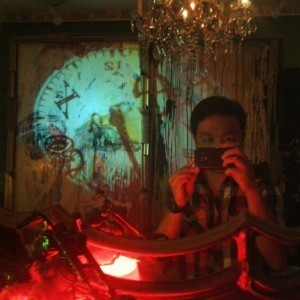 On the 25th of May, 2013, I found myself in a restaurant called Van Gogh is Bipolar. When I came to this place, I had a mission. My friends and I were making a 20-minute independent film titled ‘Blind’, and we were hunting for the perfect location for the blind date scene. This oddly-named restaurant on Maginhawa Street was first on our list. We wanted to use the place to tell a story, but, unexpectedly, we found that it had a unique story of its own.
On the 25th of May, 2013, I found myself in a restaurant called Van Gogh is Bipolar. When I came to this place, I had a mission. My friends and I were making a 20-minute independent film titled ‘Blind’, and we were hunting for the perfect location for the blind date scene. This oddly-named restaurant on Maginhawa Street was first on our list. We wanted to use the place to tell a story, but, unexpectedly, we found that it had a unique story of its own.
Van Gogh was bipolar, and so is the owner of the restaurant, Jetro Rafael. Before he was clinically diagnosed as having bipolar disorder, he thought he was crazy. He was confused and disturbed by the sudden changes in his actions, thoughts, and emotions. After his diagnosis, he accepted his condition and learned how to deal with it. Jetro eventually discovered that he could cook and he was able to concoct mood-altering food that helped him. This gave birth to the Cuckoo Diet, which he served in the restaurant. As for the meal we had, it was an experience. We had a whole cabbage as an appetizer followed by the juiciest and most tender chicken dish as the main course. We sampled so many unknown combinations and textures, both light and heavy, but found every bite delicious. The culinary masterpiece was completed when he topped it off with dessert: a shot of brown sugar and absinthe on a spoon. According to the owner, absinthe was Van Gogh’s favourite drink. Undeniably, our spirits were high by the end of the meal.
Jetro groomed his place with things that were both familiar and peculiar. I saw a low-rise table full of Alice-in-Wonderland type of tea cups for mood-setting tea concoctions—Extra Upper, Happy Chill, Extra Calming, Upper, and Light Chill. These were placed in a large, rugged wooden shelf with cabinets, along with a microscope, a pack of plastic balloons, laboratory and wine glasses, trolls, and other things that were gathered during Jetro’s travels. The walls were covered with his passion paintings depicting many faces and bodies stripped of clothing. To me, the paintings illustrated how Jetro embraces humankind in all their shapes and colors. The chairs were old-fashioned, yet some had sneakers on their feet.The bathroom had plants in white pots, a gold shoe figurine, an upside-down umbrella cradling a light bulb, and so many more. Jetro’s place was strikingly reminiscent of some of Van Gogh’s paintings, specifically The Starry Night, Café Terrace at Night, The Starry Night over the Rhone, and The Night Café. But Jetro had a way of making the place his own; indeed, this canvas of his life was a beautiful mess.
The director and I were both speechless. At some point, I forgot that we were on location hunting. Then, when we were able to absorb everything, the mission came back to us and we knew that this was the perfect place for our film. Nervously, we walked up to Jetro, introduced ourselves, and asked if we could use his place for the film. He was hesitant because he had never allowed anyone to shoot a film in his restaurant cum home before. We sent him a proposal, and a few weeks later, he said yes. I will never forget his reply: “I was impressed by your passion, guys. I love passionate beings.” This is what passion can do, I realized. The craziest part of the story? When I said that at some point I forgot that we were on location hunting, it was because after 2 years of friendship, I realized that I was falling for the guy I was with, and so was he.
I am still in awe that there is a restaurant in my country which reminded me that life could be insanely beautiful.
About the Author: I’m Patricia Era from the Philippines. I write what I love. This piece is definitely the closest to my heart.
The post Philippines: A Modern Encounter with Van Gogh appeared first on We Said Go Travel.
Reaching Out for Italy
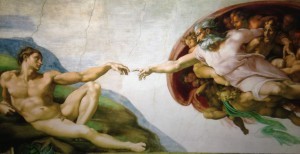 High above the swirling mosaics of the Sistine Chapel’s floor are Michelangelo’s famous frescoes. The genius of a man ahead of his time calls tourists’ heads irresistibly upwards, drawn by the intricacy and vibrancy of paint that has had centuries to dry, but remains indisputably flooded with life. Amidst this overwhelming beauty is a single tableau that embodies so much of what my trip to Italy with my father meant to me.
High above the swirling mosaics of the Sistine Chapel’s floor are Michelangelo’s famous frescoes. The genius of a man ahead of his time calls tourists’ heads irresistibly upwards, drawn by the intricacy and vibrancy of paint that has had centuries to dry, but remains indisputably flooded with life. Amidst this overwhelming beauty is a single tableau that embodies so much of what my trip to Italy with my father meant to me.
The Creation of Adam is perhaps the most well known of the frescoes adorning the ceiling of the Sistine Chapel. Ethereal colors depict God reaching for the hand of Adam, fingertips outstretched, and left never quite touching; representing the moment just before God granted life to man with just a sparking touch from his finger.
It is the space left between these outstretched fingertips that symbolizes the root of a daughter’s lifelong dream finally come to fruition. A dream I’ve held for so long, I don’t quite remember the exact moment my heart first picked it up. A dream to return to Italy, the homeland of my family’s ancestors with my father.
I’ve always viewed my father, an Italian man with a contagious smile and a ferocious love of pasta and family, as being larger than life, and he has been my hero since long before I even knew the meaning of the word. But ironically in the very beginning of our story, whose pages started to turn nearly 21 years ago now, he says he needed me; just an infant then, as much as I’ve always needed him.
Right before I was born, my grandfather died. Making it so I would never meet the man who was more than a father to my dad, but also a best friend. Growing up, I never wanted anything more than to know the person who had meant so much to the man that has always meant so much to me. I never wanted anything more than to be able to connect to this past, to fill in the gaps and the spaces, to make tangible the stories and the memories that I had just missed out on.
Italy became all of these dreams wrapped up into one. To return to the place where it all began for my family, to become one with a heritage I had never known; and to do it all with the person forever linking me with a past that remains attached to me however threadbare – the idea held the flavor of destiny, a fate delicious, like luscious mozzarella cheese over a fine marinara sauce.
My junior year in college brought me to Europe this September to study abroad in the south of France, a region just twenty minutes from Italy’s border. As the physical distance closed, so did the feeling of impossibility, and the vagueness of a far off horizon after which I assumed this dream might one day set, began to lift. And somehow, whether it was with the same preordained destiny of mozzarella cheese and marinara or not – my dad booked a flight to meet me in Rome.
It was with all of these things in mind: the infant child that passed the ghost of her grandfather on his way up to heaven while on her own route down to earth, the baby that brought a small light of something good to a man who had been plummeted into the darkness of grief, the girl who’s heart always burned with curiosity about where exactly it was that she came from; that this woman came to be standing next to her father at the center of Vatican City in the heart of Rome, Italy, craning her neck up at Michelangelo’s Creation of Adam.
And as we both stared up, father and daughter regarding the magnificent assembly of awe-inspiring tableaus beneath painted arms outstretched since the 1400’s, I felt as if something had shifted. As if fingertips immobilized inches apart had moved, had reached out just a little bit further, and met. As if in the homeland of my grandfather, I was finally in touch with what for so long had been intangible, and with that touch, a spark had ignited just as Michelangelo had painted. Not one of life, but one of identity, one of recognition, one of family.
About the Author: Katherine Miller was born in Syracuse, New York and is a junior at Marist College. She is currently living in Antibes, France, but is a true Italian girl at heart and loves pasta, pizza and gelato almost as much as her Dad.
The post Reaching Out for Italy appeared first on We Said Go Travel.
Walking With Polar Bears: The Next Great Safari
You can’t drive here; you can’t boat here; you can’t even walk here… you’d be eaten. We’re somewhere in the back end of nowhere, some 300 kilometers from the closest paved road; 1500 kilometers from the nearest Whole Foods. If you cry wolf here, everyone believes you.
It’s the third day of a week-long safari. Not in Tanzania, Botswana, Zambia or anywhere in Africa. We’re in the sub-Arctic, on Cape Tatnum, Hudson Bay, Manitoba, 57 degrees North Latitude. We’re on foot, in knee-high Wellies, sloshing single-file behind our guide, Andy MacPherson, towards a big mother polar bear. The general rule is to halt 50 or more meters from a polar bear. They’re master predators, largest land carnivores on the planet, top of the food chain, and are hungry this time of year. They feast on ice-breeding seals in the winter months, hunting from floating bergs on Hudson Bay, “The Cold Ocean.” But when the ice breaks in July, sleuths of bears come ashore and wait. There are some berries and birds, and the occasional whale carcass that washes up onto the sand. But mostly the bears live off stored fat reserves and wait for the ice to come back mid-November. It is the longest period of food deprivation of any mammal on earth. Now it’s September, when the sun describes a horseshoe around the margins of the sky, and life is beginning to drain from the land. The beasts are, at this time, justifiably famished.
Not many get to see polar bears in the wild. Most who do take a Tundra Buggy tour in Churchill, riding in giant tank-like buses that allow looking down at the melancholy wandering of Ursus maritimus without any chance of attack. Others see the bears from the decks of cruise ships plowing through the Arctic Oceans. But very few ever actually walk among the bears.
Some call Andy “The Polar Bear Whisperer.” He doesn’t disavow the title, but admits he can’t really Dolittle with the bears; rather he has come up with techniques to “keep them off balance.” Polar bears are intelligent, curious, and socially complex, he says, though there are several instinctive responses to humans approaching, and each bear has his own contextual personality and reaction. If she deems approaching vehicles, or a walking group, threatening, she might turn and run. Or she might charge. But once a response kicks-in, it is near impossible to stop. So, if kept disoriented, Andy postulates, she won’t decide on an action, but will wait for more information.
“Each time we interact with a bear we have the opportunity to add either positive or negative experiences to her toolbox,” he softly explains. “And that accumulation of knowledge affects the bear’s decision-making process.”
We have slowly walked around a long sandbar, being careful to stay downwind of “Pihoqahiaq,”(the ever-wandering one), as the Inuit call her. Her eyesight is supposedly similar to ours, but the ears are much better. And it’s very quiet here. The few sounds the polar bear knows include the crack of ice, the whoosh of wind, and the claver of geese. So, the human voice is unfamiliar, and can potentially trigger the wrong behavior.
So, Andy signals us to be quiet. The white giant, though, stands up, and begins to amble in our direction on large, silent feet. Her face is inscrutable, though the eyes say someone is home. She taps the air with her Roman nose, which has, Andy says, a better sense of smell than a bloodhound. I imagine everyone is thinking the same as me…if she attacks, who will be the slowest runner. The bear keeps stepping towards us. The Arctic air suddenly seems hot from the flame of risk. I expect Andy to back up, but instead he steps towards the bear….a face off. Andy has two small rocks in his hand, which he clicks, a sound meant to keep the bear a little off-balance. And Andy speaks to her, a note of mysticism in his voice. “Hi Beautiful. We’re just here to say hello. How is your day?” He speaks in a low monotone, which he says sounds like Charlie Brown’s teacher to the bear. It is meant to be non-threatening, and mildly confusing. The bear and Andy keep moving closer, and we obediently stay behind, and formally still. I look around to scope an escape route, but there is nothing. We’re a kilometer from the taiga forest, which doesn’t have a tree worth climbing anyway. On the other side, the second largest bay in the world, named for doomed explorer Henry Hudson, with water deadly cold, and bears are faster swimmers anyway. Behind is a loamy coastline, desolate as the mare on the moon, and polar bears can out run a race horse from a standing start. I recall a bit of advice I heard from a guide years ago on the Seal River: “Most polar bears are left-pawed, so if the beast charges, leap to her right.” But I used to be a guide, and know the adage true: “How do you tell if a guide is lying? His lips are moving.”
Regardless, all bets are on Andy. He continues to step forward, facing the bear, eye-to-eye. He clicks the rocks. Slung around his shoulder is a 12-gauge shotgun; on the belt of his camouflaged chaps, a starter pistol and a can of pepper spray. His back-up: Albert Saunders, a Swampy Cree born near here, bringing up the rear, and equally equipped. Albert has worked this coastline for years, laying trap lines in the winter, and hunting polar bears, with binoculars, in the summer.
Finally, less than 20 meters from one another, the bear turns, and plods away, like a bulldozer back to the yard. It would have taken her seconds to leap forward and rip off Andy’s head. But she chose something else. We all let out sighs. It was, all and all, a sublime encounter, an agreeable kind of horror.
The 18th century Irish philosopher, Edmund Burke, tried to account for the passions evoked in the human mind by what he called “terrible objects.” He was interested in our psychic response to things that seized, terrified, and yet also somehow pleased the mind by dint of being too big, too fast, too powerful, too uncontrollable to be properly comprehended. He wrote: “Whatever is fitted in any sort to excite the ideas of pain, and danger, that is to say, whatever is in any sort terrible, or is conversant about terrible objects, or operates in a manner analogous to terror, is a source of The Sublime; that is, it is productive of the strongest emotion which the mind is capable of feeling.” He went on to summarize that terror was a passion that “always produces delight, when it does not press too close.”
There are few places where one can plunge into the reality pudding of proximity to an ice-loving ursid, or any large predator, on the ground, in the field, eye level, with no fences or glass between. The Nanuk Lodge, named for “the master of the polar bears” in Inuit mythology, is one such place.
It takes at least two days to get to sub-Saharan Africa from almost anywhere in North America, and once there it takes a few days to get through the fog of jetlag. It takes me a day to reach the western edge of Hudson Bay from Los Angeles, two time zones away, arriving in time for moose burger soup, and an afternoon safari into the habitat of the Monarchs of the North.
I fly commercial to Winnipeg, capital of Manitoba, and then Calm Air to Gillam, a dam town on the Nelson River, and finally a charter Britten-Norman Islander over endless spots of water that look like human eyes glittering or brooding, as the mood strikes, mirroring, it might seem, the soul of the landscape. We bank sharply, and then swoop to land at the small dirt strip in front of Nanuk, corrugated with footprints the size of hubcaps.
Nanuk Polar Bear Lodge, owned by Churchill Wild, is surrounded by a 10′-high page wire fence, evoking the feeling that we, the humans, are in the zoo, especially when the animals rear haunches and place paws on the linkage. Inside the fence is a boneyard of animal skeletons found nearby, adding to the Planet of the Beasts sensation. Within the first few hours a black bear and a polar bear circle around our cage, looking for a way in. They bite, shove and pull at the wire mesh. We climb the wooden viewing tower, half as an added precaution. The polar bear finds a cardboard box, filled with empty wine bottles, awaiting an air pickup, and sticks her snout in for a few good sniffs. When she finally chooses to move on, we retire to the Common Room, and snack on caribou bacon wraps, and sip pinot noir in front of the large handmade stone fireplace, backed by a huge bay window that looks, when a bald eagle perches on a black spruce outside, like a giant screen saver.
We’re utterly, completely, totally off the grid, except for the satellite Wi-Fi. The protracted twilight is spent reviewing digital photos of the day, thousands of them, posting on social media, and generally committing philosophy. The group is mostly Australian, and a few Canadians. My friend Didrik and I are the only Americans, or South Americans as some Canadians consider anyone from south of the 53rd parallel.
Dinners are Northern gourmet, freshest tundra-to-table to be found, as Riley the cook hunts much of the fare just beyond the fence. The exception being the quinoa chocolate cake, which I suspect took some ingredients not within walking distance.
The following days are rich with sensation and awe, and the simple admiration that wildlife can survive in an environment that would defeat us in very short order. After breakfast we board one of the two open-air lodge vehicles, a standard Honda quad bike, and a custom-built 8-wheel drive “aluminum rhino” (a Geo Metro engine inside, and moose antler for a stick shift… it looks, from the front, a cross between the #5 robot in the movie Short Circuit and WALL-E). Neither vehicle offers any protection from 1000 lb. feral quadrupeds, but that’s the point. As our space station of a lodge fades into the distance we witness flights of avifauna fancy, from avalanches of snow geese, to peregrine falcons, to tundra swans, golden plovers, and the rubber ducky horn perched on the silver rhino. We carve an anfractuous path along a land so raw it looks as though the clock has been reset to zero, across silt flats, peat lands and sedge grasses, through vast, luminous country that provides the supremely satisfying sensation of existing in the midst of something absolute…even if it isn’t.
On the second day, under light that is soft, diffuse and intense at once, we trundle out through bogs and boreal forest towards the mudflats, and at the verge of a small river two black wolves, in full autumnal pelage, lope across our paths. We stop; they stop. The wolves are so fine-looking, but practically pulse with power and barely suppressed savagery. The tension between beauty and violence could snap a winch cable. They approach, and cautiously circle our vehicles. They snuffle, like dogs, and step within a few feet of us. It’s such a naked, raw, unpredictable experience, knowing that a random, inexplicable tap could trigger a Siegfried and Roy tiger attack. Or what happened to Timothy Treadwell, The Grizzly Man. Or SeaWorld orca trainer Dawn Brancheau, as recounted in the film Blackfish. It would take a trice for the wolves to get to us, to drop us like caribou. But, after several minutes of consideration, they turn and lumber off like shadows into a thicket of birch and bush.
Each day we set out in our all-terrains, bobbing through the landscape like boats in a storm. We constantly scope the unsummarized shores of Hudson Bay, and with wildlife sightings, dismount the vehicles and watchfully walk as close as Andy deems safe. In this original scape we witness a range of polar bear behavior, up close and personal. This is the season, and the prime place, for mothers and c.o.y.s., “cubs of the year,” and we gawp as a mother and her two cubs rest in a day-nest scooped from the sand beneath a turning willow, when another mom, with three cubs trailing, comes galloping across the badlands, either ready to pounce, or fleeing from some unseen hazard. Regardless, the first mom takes no chances, and hastens out of her nest, while the running bear and cubs take over the spot, and settle down. It’s a bear country jamboree. Under streaks of bone-colored clouds, scratches in the sky, we watch patiently as a bear holds it head like a sphinx, taking her own council, never moving a wit. Another pair on the beach stands erect on hind legs, like taxidermies in The Explorers Club, and battles one another for some sort of dominance. I glass the scene with my Steiners and watch their white fur rippling like a field under wind. Another mother emerges from an inlet, shaking the water from her fur like a huge dog, sending out a bloom of spray that glitters in the air like grains of mica. She then swaggers up a small hummock, and turns our way, massive shoulders rolling, expressionless eyes boring into ours. When her big sloped head yawns we all try not focus on the size of her teeth. Every time she moves, Andy clicks his rocks, as though the two actions are connected by a string. It’s all very human-like, and comprehensible, even if we don’t really know anything of what she is doing or thinking. Then, she stops, lies down, and ignores us, so we head back the lodge.
“Quork, quork, quork:” the sound at the door, the one with the moose antler handle. Andy enters cupping a wood frog in his palms. It is the cryogenic Walt Disney of Manitoba, in that it spends its winter, frozen solid, but then thaws out to full animation about the time polar bears are leaving the ice for land in the summer. Despite the violence outside our windows, inside Nanuk I am threatened only by a surfeit of tea, hospitality and a tiny green frog.
On the final night, after a dinner of fresh trout, we’re interrupted during a dessert of Pavlovas and cream with an uninvited guest, a polar bear at the fence rattling the postern. But as if the scene is not rich enough, the clear night sky begins to light up with the Aurora Borealis, looking like something at the edge of a dream. What a combo…a giant ice bear at our gate, and the Northern Lights above.
We gather outside, into air dank as an oyster, to bathe in the light of this optical phenomenon. I feel as though inside some great fishbowl, a captive on the inside, peering out to a larger universe. A thin nebulous cloud of green appears directly overhead and hovers, changing every few seconds. Suddenly, the fishbowl is alive as flickering tongues of jade lick the “glass” of the bowl, and dancing flames encircle us, spreading up toward some unknown height. Noiselessly they build to a pulsating green, then grow into an electric, dizzying fury. I wrap one hand around the porch rail in a death grip, and place the other over my brow as though to shade my eyes. Finally, I have to head to my room to avoid vertigo.
Gloomy is the day of departure, the surface of Hudson Bay like the lacquered black of Japanese wooden boxes. Looking back at the needles of light flashing over the water, I can’t help but admire this union of what is beautiful and terrifying, this place, which has, until recently, repelled the meddling of Man. For so much of human history we’ve lived to dominate the natural world, believing the earth a machine that would never break. We are victims of the shears that cut man from nature and nature from man. We today have few elevated conversations with the land, little sense of interconnectedness. Whatever one’s personal belief system, this landscape, and a safari through it, can provide vital perspective and bearings; can feed the springs of reverence and affection; can quicken our sense of wonder, provoke the imaginings of death, eternity and infinity, and inspire us to great deeds of preservation. More than almost any experience, a stay at Nanuk, validates our brief trek in time; and keeps the wolf of insignificance from our door.
The post Walking With Polar Bears: The Next Great Safari appeared first on We Said Go Travel.
Merzouga, Morocco: A night among the stars
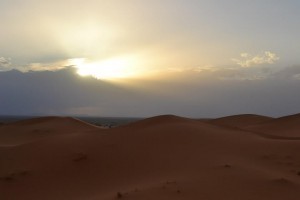 “Just hold on tightly, Fatima,” said the Berber man as I felt myself being thrown forward, and almost a second later felt myself being dipped back as my camel stood up. The name ‘Fatima’ had become almost second nature to me as our driver, Omar, had christened me as such from the start of our 2 day journey to Merzouga, the start of the Saharan desert in Morocco. At first, I thought perhaps he just didn’t understand my American turned British accent, but I soon found out that ‘Fatima’ was the name of the prophet Mohammad’s favorite wife, and it was a sign of respect.
“Just hold on tightly, Fatima,” said the Berber man as I felt myself being thrown forward, and almost a second later felt myself being dipped back as my camel stood up. The name ‘Fatima’ had become almost second nature to me as our driver, Omar, had christened me as such from the start of our 2 day journey to Merzouga, the start of the Saharan desert in Morocco. At first, I thought perhaps he just didn’t understand my American turned British accent, but I soon found out that ‘Fatima’ was the name of the prophet Mohammad’s favorite wife, and it was a sign of respect.
The mix of French, German and Spanish brought me back to present as I surveyed the diverse group around me. Our twelve person group was just about to start on our overnight trip across the Saharan desert. An hour later we stopped our camels to take in the sun setting over the dunes. Despite being only an hour away from the village of Merzouga, as I looked around me, I felt like I was floating in the middle of a golden ocean. The sight of the dipping dunes turning from a golden color to a greying hue as the sun finally dipped out of sight, is breathtaking.
“Arch, come try this,” called my husband with a childlike excitement in his voice, once again bringing me back to reality. In his hand he held a sand board, which is exactly like a snowboard, except on sand. I turned just in time to see him jump on the board, and just as quickly fall off the board. The sand was too soft to fly down the slopes as we had imagined. He decided to improvise and sat down on the board and slid down.
Before we realized it, night had descended upon us turning the scorching golden ocean into a cool, black sea. Sitting on top of the dunes as the sand flitted across our face is a humbling experience. The world seemed so far away and I don’t think nature has ever made me feel so small. I looked up and the sky was bejeweled. I felt so close to the sky that I almost felt as if I could reach out and catch a star.
I suddenly felt a light shining on us (no it wasn’t a falling star), and my rumbling stomach confirmed it must be a call to camp for dinner. As I walked down the slope, I could hear the Berber man calling “Come Fatima, come”
About the Author: Archana Shastri is a communications professional, originally from New Jersey, now residing in London. Travelling and writing are two of her passions.
The post Merzouga, Morocco: A night among the stars appeared first on We Said Go Travel.
December 2, 2013
Santorini, Greece: Spilt Paint
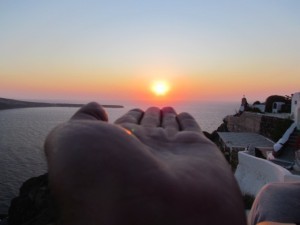 My trip around Eastern Europe in 2011 had a visit to Santorini. This island took my breath away and this is what it inspired me to write.
My trip around Eastern Europe in 2011 had a visit to Santorini. This island took my breath away and this is what it inspired me to write.
Santorini is built on the rim of a volcano overlooking a caldera. Even though we sort of, kind of knew what a caldera was it never hurts to double check. For the rest of you who are also not sure, a caldera is a “large, basinlike depression resulting from the explosion or collapse of a volcano”. Just what we thought but it never hurts to clarify. Lonely Planet advises, on arrival into Santorini, to catch a big open air ferry to receive the most spectacular view of the caldera.
However the ferry we caught depended more on budget so we were on the speedy one that was all enclosed. This did not lessen our amazement at the sight of the caldera as we coasted into the port. The sheer cliffs that drop straight into the ocean with their tinges of red and pinks strewn through the rock, give way to the crystal clear waters of the Aegean. You can still tell the outline of the still active (no its not extinct) volcano with the rim almost apparent the whole way around. Along with the truckloads of other eager tourists we nudged (okay pushed) our way onto the shuttle bus and gripped the seats tightly as the bus wove its way up the windiest, narrowest, most gut-wrenching road I have ever been on to drop us off at the bus stop where we then proceeded to board another bus.
We had emailed our hotel previously to ask for directions (remember the 5 P’s) and knew exactly what we were doing. After disembarking off our second bus we then had to walk downhill, lugging 25kg of luggage, praying to God it wouldn’t roll away, dodging traffic to reach our hotel. Angeliki greeted us and showed us to our awesomely located room. We were staying in Firostefani which is the next ‘village’ from Fira (Thira). Fira is the main hub and has the hustle and bustle of all those monster cruise shippers every day. Our hotel was a 400m walk from the hub and even better, we had a room with an ocean view. Before you ask, we didn’t have a view of the caldera because you would have to sacrifice an organ for that but a view of the other side of the island. The first thing to do was to view the caldera from the top so into Fira we went. For those of you who have been to Santorini you understand what I am about to say, for those of you who haven’t….pay attention.
Viewing the caldera from the white and blue of the village is enough to bring a tear to your eye. The absolute and utter beauty and natural wonder lets you know that you must be standing in one of, if not the most beautiful place on earth. Look to your left and you see the escalator of white cubist residences scattered down the hillside with bumpy, lumpy winding paths leading you in, out and around. Beyond them is the endless blue of the ocean until it meets the light haze on the distant horizon. An endless blue sky as far as the eye can see with not a cloud in sight. Look to your right and you see more of the same but with a whole different score of shadows lighting them. The buses and boats down at the old port look like nothing more than toys as they scurry around at the water’s edge. Donkeys ramble up the path of 570 steps, ferrying tourists up and down all day with their donkey bells jangling with every step.
Then comes sunset……this is when you look straight ahead. Santorini is famous for its sunsets and now I know why. Bars, restaurants, cafes and even the village edge become crammed with people happy to stand for an hour or so to watch the day end. If you can grab a seat then you’re one of the lucky ones. The sun taunts you with its slow descent into the haze. Every few minutes the sky changes colour and the shades of blue begin to change to pinks, reds and oranges. The days we were there, there were no clouds and the colours would radiate straight out along the horizon like spilt paint following a crack in the concrete. All of a sudden it begins to disappear behind the island in the middle of the caldera and then within moments it is gone. It has become sick of teasing us and just wants to go to bed. What amazes me is that something that happens every single day in our life as we are rushing around to do all our ‘important stuff’ becomes like a freeze frame of life when you are on Santorini. Basically nothing I say can really describe the beauty of this moment and the sunset alone is worth the trip. If you haven’t been to Santorini then put it on your list immediately.
Back to our sunset mission, we scouted for the best spot, rounded up some beverages from the corner store and sat on a concrete wall waiting for ‘the moment’. As the time got closer and closer more and more people began arriving, all there to watch the sunset. When it was finally over we decided to do our ‘dinner dance’. Making our way back up the hill we were met with a traffic jam of people. What we hadn’t realised while we were perched on our concrete seat was that hundreds, maybe thousands, of people had congregated in every available, nook, cranny and perch to watch the sunset.
The sunset at Oia is supposed to be the best sunset view on the island, we disagree. When the sun sets from Fira, the island in the centre of the caldera splits the light like a rainbow of warm colours making it more magnificent, we think, than Oia.
Nights in Santorini were spent walking the lanes, finding good food and wine while days were spent in the sun. It was sad to leave but only because we did not know what awaited us.
About the Author: Angela Beresforde: Australian Primary School Teacher/lover of good writing and appreciator of beauty.
The post Santorini, Greece: Spilt Paint appeared first on We Said Go Travel.
Inspiration From Within
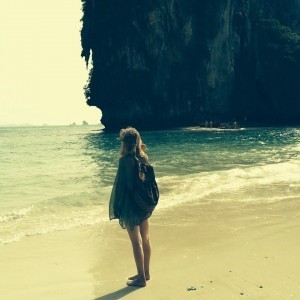 As a society, we are quick to share our positive experiences. Social media allows us to post updates immediately after a dream job offer, a proposal, or a trip to paradise. I believe the ease and accessibility of it all gives us a false perspective of our friends. I, like most, fall into the “comparison trap” of looking at other peoples’ lives from behind my screen and thinking, “They are so lucky” or “why isn’t that my life?”
As a society, we are quick to share our positive experiences. Social media allows us to post updates immediately after a dream job offer, a proposal, or a trip to paradise. I believe the ease and accessibility of it all gives us a false perspective of our friends. I, like most, fall into the “comparison trap” of looking at other peoples’ lives from behind my screen and thinking, “They are so lucky” or “why isn’t that my life?”
For whatever reason, talking about darker times and sharing less-than happy experiences is a bit taboo, so what we read online is usually only half the story. It would be easy to share the stories of my trips abroad with a fine sugar coat, but I prefer to live more transparently than that. Where I am, what I have seen and the person I have become would not mean anything without the journey it took to get here.
When I was 15, I began a long-time battle with an eating disorder. For years I was in and out of appointments, hospitals and rehab. It became the only thing that mattered to me and I lost every ounce of myself through the process. Eventually, I surrendered my body and braced myself to face the worst.
During my last (and final) visit to the hospital, a therapist challenged me to set one goal for the future. At the time, I had no plans for the following week, never mind the next year, because I didn’t think my body would survive much longer. Then, one day I thought about traveling. I thought about what it would be like to see the other side of the world, to splash around in foreign seas and explore unknown lands. For the first time since being consumed by the deadly voice in my head, I was able to imagine a future for myself. Lying in the hospital one evening, I decided I would recover and see the world. With that, I started the process of giving up my eating disorder and I contracted a new disease: Wanderlust.
Recovery was a long and painful process, as it is for most people with addictions, but I was determined and persistent. By the time I was 22 I was emotionally, physically and spiritually sound, and I was confident in my ability to lead a healthy life on my own. I packed my belongings into three bags, got on a plane four planes and flew from Florida to Cambodia to become an ESL teacher.
Once I received my TESOL certification, I moved to Chiang Rai, Thailand where I was hired at a small Montessori school. After I had been teaching for nine months, my family journeyed to my side of the world for some rest and relaxation in the Land of Smiles. We spent four days exploring the islands surrounding Krabi. I had previously seen pictures of Krabi’s postcard sunsets and flawless sea, but I never could have imagined the breathtaking views I was able to see during my vacation. Despite the fact that Krabi is a tourist destination, its natural beauty is undeniable. No amount of people could take away from its picturesque scenery.
During a day trip to Railay Beach, while cruising through the crystal blue waters in a long-tailed boat, feeling radiations of love from my family and the Universe as I looked out at the perfect view, I found myself thinking, “I have arrived. This is life, and it is so effing amazing.” I remembered the 16-year-old version of myself—the girl who barely had enough strength to stand, who had no hope left and who had lost herself completely. I immediately became so overwhelmed with love and gratitude. I breathed in the fresh, sea-salt air and exhaled a quiet “thank you” to my former self. A thank you for believing a better life was possible, for bringing me to paradise, and for letting me experience everything I had dreamed of. I thanked her, and I was in awe of her…I was in awe of myself. I had set a goal, kept my promises, and (against the odds) I succeeded.
It’s hard to feel connected to the person I was and the person I am because we are very different. I often think back to Hermann Hesse’s words, “The river is everywhere.” I am she and she is I. No matter where this life takes me, my past will always be a part of my present. I truly believe that the struggles and so-called “bad times” are the parts of our lives that paint our stories with color. Those are the parts of life that allow us to experience awe in all of its purity and appreciate how beautiful this journey really is.
About the Author: Melinda Nelson fancies herself a land-roaming mermaid. She currently works as an ESL teacher in Chiang Rai, Thailand and is passionate about her volunteer work with the National Eating Disorders Association. Melinda believes in “paying it forward”, feeling connected, good energy, and hugs. You can contact Melinda on Facebook or follow her journey on her blog.
The post Inspiration From Within appeared first on We Said Go Travel.
Using Nokia Lumia 925 for We Said Go Travel
Thank you to Nokia Connects for sharing a Nokia Lumia 925 with us and letting us write about it on their site!
Seeing the world is many people’s dream, and with inventions like the commercial airliner, taking time out to explore cultures and climates around our planet is very possible in this day and age. Having a powerful and reliable device to record our adventures is also within our grasp, and that’s why we have traveller and writer, Lisa Rajna, to tell her story of when she took the Lumia 925 with her to South-East Asia…
“The powerful camera was far superior to what we were using and the Internet access and applications that were available opened up a new world with this innovative device”
My husband, George, and I took a sabbatical year in 2008-9 and travelled for eleven months in twelve countries mainly in South-East Asia. During our meanderings, we explored incredible UNESCO sites like Borobudur in Indonesia and Ayutthaya in Thailand, snorkelled and scuba-dove in Sipadan, Borneo and came face to face with a variety of cultures from Indonesia to Mongolia. With all the walking and smaller food portions, I lost nearly sixty pounds and was thrilled with the new me. On the second anniversary of our first date, George asked me to marry him underwater in Koh Lipe, Thailand. I never imagined that technology would be an important part of our life and our adventures but after meeting online I should have guessed that it would be.
Before I met George, I was still using film to take pictures; however, as I evolved inside and out, I joined the digital revolution! After returning to Los Angeles and getting married at the location of our first date, we started a blog called “We Said Go Travel” to share our journeys. Armed with an HD flip video camera, we began shooting video and opened a YouTube channel under the “We Said Go Travel” name.
Click here to read the full article!
More videos with Nokia Lumia 925
The post Using Nokia Lumia 925 for We Said Go Travel appeared first on We Said Go Travel.
December 1, 2013
Algonquin National Park, Canada: Moose
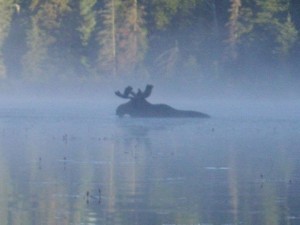 It was cold. We moved quietly, silently, around the campsite. The morning was barely breathing and the pale grey light held the landscape in suspense.
It was cold. We moved quietly, silently, around the campsite. The morning was barely breathing and the pale grey light held the landscape in suspense.
“I’ll go in a canoe with you,” whispered Lucy.
Without much need for communication from our leader, we launched the canoes and climbed in. The lake was cold, my legs were cold and by the time the canoes were steadied from the motion of the ripples, my hands were cold. But we weren’t going to miss this for anything. A sunrise canoe, with the hope of sightings of moose, was worth the early morning, stiff, roll out of sleeping bags from the hard ground.
“This is a silent paddle,” hushed our guide, as another member of the group exclaimed at the view across the lake. We all fell into silent thoughts and concentrated on getting the canoes off the shore with as little sound as possible. The mist was floating, hanging, as though shielding the lake from our view.
Paddling was slow as we tried not to splash: lean forward slightly, paddle in, pull back slightly, and lift away from the water with care. The first few minutes took all my concentration on getting the stroke right. The island, with our tents at the edge, disappeared through the mist and the figures in the canoes seemed as statues, appearing momentarily in the featureless, shrouded surroundings. We were in the Algonquin National Park, Northern Ontario and I had planned this trip some time before, as I wanted my children to experience the remoteness of this corner of Canada. That morning, it felt as though we were the first people on Earth, as we paddled through the shards of sunlight from the dawn.
We canoed east, into the low sun and the silver danced off the lake, intense and blinding as we headed away from the lee of the trees and onto the open lake. Over to the next island, the sun now higher in the sky, and the colours of the Canadian wilderness taking over the day.
“Even if we don’t see a moose, this is enough in itself,” I thought. Blue sky, blue lake, the shore cloaked in hues of green.
Then I noticed the silent, excited gestures from the other canoe: hands raised to head height, fingers waggling, the agreed sign, and faces urging us to catch up with them. And there, just round the corner, the Canadian moose. He was in the water, head and back showing, and those magnificent antlers. He was feeding on the lilies and appeared not to have noticed us as our four canoes took up position about twenty metres away. The mist held his features at bay, the silence respected his presence.
His breakfast was a long and leisurely affair. We watched as he took in a mouthful of lilies, chewed them slowly, nose in the air momentarily, and then lowered his huge head and antlers for another mouthful. We edged closer, under the signals of our guide and started photographing him. The click of the cameras were discernible but the moose showed no signs of discomfort at our presence and just carried on, standing there in the water, bowing his head to eat every now and again.
But he was prince of the morning and we were privileged to be passing through. We were so close to him now, that we could hear him chewing his watery green delicacies. Somewhere in the misty green, a woodpecker tapped. Then, after timeless minutes, the moose shifted slightly in the water. Was he signalling an end to our audience? We watched as he turned slowly, paused a moment and waded back to the shore. Still graceful, he stepped out of the lake and onto the shore and, without a backward glance, moved into the shadow of the trees. We could hear the crack of undergrowth and twigs, as the forest tracked his progress.
I took a first breath and turned to look at the faces of my family and companions. Morning smiles all around.
About the Author: Sharon Jenkins Carter is a teacher and a language trainer with a love of the outdoors and a wandering spirit. She enjoys immersing herself in different cultures and meeting with people from all walks of life.
The post Algonquin National Park, Canada: Moose appeared first on We Said Go Travel.
We Said Go Travel
We Said Go Travel is a global community of over sixteen hundred writers with articles from every continent.
Stories are shared with photos and video from a perspective of the transformative power of travel. We Said Go Travel has hosted live and online events as well as travel writing contests around the world. ...more
- Lisa Niver's profile
- 57 followers



